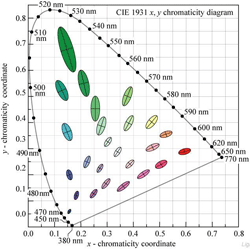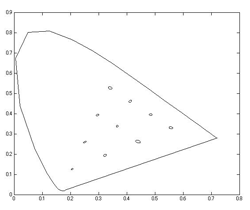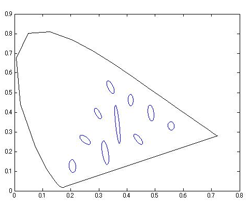Top>Research>Research on Color Vision and Colorweak Compensation
 Index
Index

Chao Jinhui [Profile]
Education Course
Research on Color Vision and Colorweak Compensation
Chao Jinhui
Professor of Computer Science, Faculty of Science and Engineering, Chuo University
1. Human color perception and color-weakness
Why can the human eye see a variety of colors? This simple question has continued to spur intellectual curiosity since the times of ancient Greece. Today, the Young-Helmholtz trichromatic theory has been confirmed by the existence of L, M and S cone cells in the retina which sense colors of red, green and blue . Furthermore, in order to decipher deep mysteries related to color perception, a wide range of research has been conducted through physical, physiological and psychological approaches including study of information processing mechanisms in the human brain.
Recently, there has been a rapid increase in the population possessing personal terminals such as computers or smartphones. There are a large number of projects seeking a universal design in order to enhance both visibility of displayed information and user amenity.
As a part of paradigm shift to human-centered science and technology, adaptation of the visual information and the compensation of the color vision of color-weak observers is one of the most important and challenging tasks in universal design and barrier-free IT technology.
Color blindness is mainly caused by a defect in one of the L, M or S cone cells in the retina. However, a through defect of a single cone is not always the cause of color-weakness. Instead, abnormalities in color perception can be caused by a variety of genetic and acquired factors. As a result, the form and degree of color-weakness varies greatly depending on the individual. Approximately 5% (1 person out of 20) of Asian males are color-weak for red and green. This percentage is about 8% for Caucasian males and approximately 4% for African males. The same color-weakness occurs in approximately 0.2% (1 person out of 500) of Japanese women. This equates to about 3 million men and 120 thousand women from the entire Japanese population,comparable to the population of a single major city.
2. Universal design and compensation of color-weakness
The majority of people with color perception abnormalities is consisted of color-weak obersers. Currently, a variety of compensation methods are available for colorblind people. Such methods include compensation using glasses or a filter, ussag of compensation software on computer displays, and color design based on colorblindness simulation. However, methods which differentiate ground and text by amplifying the color contrast between them are mainly useful for images such as text or symbolic information. These methods cannot be applied to complicated color images such as natural images.
On the other hand, in the case of people with color-weakness, there are no effective methods which can cope with individual differences in color perception. In particular, human color perception possesses complicated characteristics which differ for each color. It is impossible to externally observe such characteristics, which makes it difficult to create an objective model of colors seen by humans. Accordingly, it is impossible to objectively measure the degree of color-weakness and the necessary extent of compensation, therefore to objectively determine the compensation rate or compensation criteria. Even more, color-weakness and other characteristics of color perception are complicated phenomena which are unique to individuals. In principle, it is difficult to conduct precise color compensation as required for different individuals . Another major obstacle is absence of linearity and reproducibility of human perception. All of these complications have made it difficult to find a precise and objective method.
3. What is color discrimination threshold?

Figure 1: MacAdam ellipses
In spite of the well known fact that color science frequently is greatly influenced by objective factors, it is possible to objectively measure the color discrimination threshold, which is data regarding the minimum color difference at which it is possible to distinguish between different colors. The possibility of objective measurement makes color discrimination threshold the most important characteristic of color perception with small color differences. Figure 1 shows the MacAdam ellipses (enlarged 10 times). MacAdam was the first researcher to measure the thresholds on the chromaticity plane. When one departs from the center of the ellipse and changes the test color in a certain direction, human observers will not immediately notice the change in color. The entire set of colors closest to the center point at which difference is perceived is the color discrimination threshold for the center color and is in the form of anellipse The size and direction of ellipses changes for each color. It is particularly difficult for people with color-weakness to distinguish colors in a direction of their ellipse which extends further than people with normal color perception. Generally speaking, color discrimination threshold data is unique to each individual and expresses the unique color perception characteristics of the observer.
Our research started from trials to see if this data could be used to create a compensation method for individuals with color-weakness.
4. Colorweak compensation based on color discrimination thresholds
First, from the common sense that the color discrimination threshold ellipse, as colors with the same color differences from the center point, should be shaped like a circle, one could understand that this data actually describes distortion or curveness of the color space of each observer. Riemann geometry is a mathematical method that handles such types of curved spaces. Using tools inthe Riemann geometric theory, we discovered a method to connect the color discrimination threshold data at each color with objective color differences of the entire color distribution. We then derived correspondence between the colors seen by people with color-weakness and people with normal color perception, as well as an objective criterion for compensation of color-weakness. In other words, we used the color discrimination threshold as a basis for creating a color perception compensation method which shows the same color perceived by people with normal perception to people with color-weakness. This method can be adjusted for each individual.
In order to express human color perception in a form which can be objectively assessed, we first used a psychophysical experiment to measure the color discrimination threshold of people with color-weakness and people with normal perception. Figure 2 shows the average ellipses measured as the color discrimination thresholds of people with normal perception, while Figure 3 shows the ellipses measured as the color discrimination threshold of a person with colorweakness.

Figure 2: Threshold ellipse of people with normal color perception

Figure 3: Threshold ellipse of a color-weak observer
Using the compensation criterion discussed above, we applied the proposed model to natural images in order to generate an image of color seen by people with colorweakness from the perspective of people with normal perception (known as a color weakness simulation), as well as a compensated image which shows people with colorweakness the same colors that are perceived by people with normal perception. We confirmed compensation results by performing both quantitative and subjective assessment of this color weakness simulation and color weak compensation
Figure 5 shows the original image, Figure 4 shows the image of the colorweakness simulation, and Figure 6 shows the compensated image.

Figure 4: Color weak vision simulation

Figure 5: Original image

Figure 6: Compensated image
- Chao Jinhui
Professor of Computer Science, Faculty of Science and Engineering, Chuo University - 1982: Graduated from Department of Electronic Engineering, Xidian University, China.
1986: Received his MS degree in electrical/electronic engineering from the Graduate School of Engineering, Tokyo Institute of Technology.
1988: Received his PhD degree in electrical/electronic engineering from the Graduate School of Engineering, Tokyo Institute of Technology.
1989: Became Assistant Professor of the Faculty of Engineering, Tokyo Institute of Technology.
1992: Became Associate Professor of the Faculty of Engineering, Chuo University.
1993: Assumed his current position.
Research interests include human information processing, image media, and elliptic/hyper-elliptic curve cryptography.
- Research Activities as a Member of Research Fellowship for Young Scientists (DC1), Japan Society for the Promotion of Science (JSPS) Shuma Tsurumi
- Important Factors for Innovation in Payment Services Nobuhiko Sugiura
- Beyond the Concepts of Fellow Citizens and Foreigners— To Achieve SDGs Goal 10 “Reduce Inequality Within and Among Countries” Rika Lee
- Diary of Struggles in Cambodia Fumie Fukuoka
- How Can We Measure Learning Ability?
—Analysis of a Competency Self-Assessment Questionnaire— Yu Saito / Yoko Neha - The Making of the Movie Kirakira Megane








